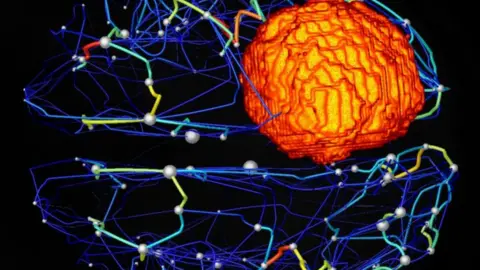'Virtual brain operation' moves a step closer to reality
 Hannelore Aerts
Hannelore AertsSoftware that can map the structure of an individual human brain is being trialled in Belgium in tumour patients.
Researchers at Ghent University modelled the brains of 25 tumour patients and 11 controls.
They found that the software could accurately predict the effects of the tumour on brain connectivity.
Doctors hope to combine neuroimaging data with virtual brain modelling to improve surgical planning and outcomes in the future.
Study researcher Daniele Marinazzo told the BBC: "We can therefore think of doing a 'virtual operation', removing parts of the brain, or cutting the connections between them, and seeing if we can predict what actually happens, and how the large-scale dynamic balance of the brain is changed."
Before a patient is operated on, surgeons use brain scans to plan the best way to remove the growth.
However, it is difficult to predict the outcome of surgery because of the complexity of the human brain.
'Fantastic research'
Simulating the brain using open source software known as The Virtual Brain allowed the researchers to understand how tumours affect brain connectivity.
This could allow doctors to plan surgery that gives the best chance of removing a tumour while keeping the rest of the brain tissue intact.
The conventional procedure for mapping tumours is to use non-invasive imaging techniques such as functional medical imaging (fMRI).
Niels Janssen, a neuroscientist at the University of La Laguna on the island of Tenerife, said: "This is fantastic research that shows how theoretical models of the brain can be useful in practice.
"We really need this research because it could help doctors make better surgical decisions and improve the life of the patients."
The research is published in the journal, MeNeuro.
Follow Shivani on Twitter.
